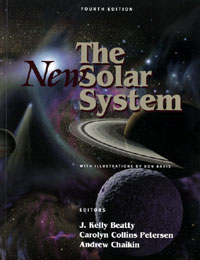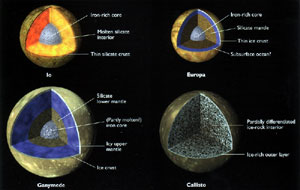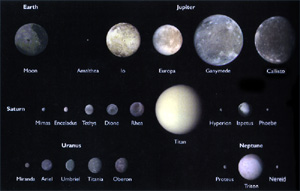The New Solar System
4th Edition
J. Kelly Beatty,
Carolyn Collins Petersen,
& Andrew Chaikin
Sky Publishing: Cambridge, Massachusetts
Cambridge University Press: Cambridge, United Kingdom
True wonders
 The New Solar System is quite a big book of wonders, and I mean that very sincerely.
The New Solar System is quite a big book of wonders, and I mean that very sincerely.
This is the fourth edition; previous editions were in 1981, 1982, and 1990, and this edition is 30% larger than the last one. At 8.5 x 11 inches, it holds clear and informative text in substantial chapters by some thirty planetary scientists, and a visual wealth as not seen in any other single place. Almost every page has truly fine photographs, art by Don Davis, and/or illustrations by Sue Lee. The astronomical photography and the creative visuals are beautiful. The well-written chapters have fascinating details — revelations to many of us — from recent years' space probes. Editors Beatty, Petersen, and Chaikin have done a fine job of putting all this together:
In assembling this book, we have attempted, as before, to bring the fruits of recent planetary exploration to the widest possible audience. This is neither a textbook nor a "coffee-table" volume — it lies somewhere in between. By the same token, we have encouraged our authors to avoid both sweeping generalizations and incomprehensible details. An abiding theme has been that our solar system is no longer a collection of individual bodies that can be addressed in isolation. It is instead an interrelated whole, whose parts must be studied comparatively. Above all, we strove to make this enjoyable reading for those with either casual or professional interest.
The fly-bys past other planets and moons in the Solar System have brought us close-up knowledge as never before available.
Since it must be a great impediment unto the growth of sciences, for men still so to plod on upon beaten principles, as to be afraid of entertaining any thing that may seem to contradict them. An unwillingness to take such things into examination, is one of those errors of learning in these times observed by the judicious Verulam [Francis Bacon]. Questionless there are many secret truths, which the ancients have passed over, that are yet left to make some of our age famous for their discovery.
John Wilkins
The Discovery of a World in the Moone
or, A Discourse Tending to Prove
that 'tis probable there may be another habitable World in that Planet (1638)
There's way too much in The New Solar System for me to cover adequately, so I'll concentrate on three areas that I find of special interest personally: mapping; resources; and impacts. In the course of following the ongoing news from better telescopic views, the space probes, and the analysis of data, we've all picked up some of the progress that's been made. Putting it all together shows, though, the great strides in knowledge and gives us a far richer understanding of the Solar System. So, a hint of the detail in just three areas, below.
Mapping planets & moons
I had not realized that planetary scientists have been seeing and naming surface features on all the planets except the gas giants, and on all the primary and even secondary moons. Even on the gas giants, persistent storms or other atmospheric anomalies like Jupiter's Great Red Spot have been discerned. Craters, plains, and ridge complexes have been named on Mercury. Uplands and impact craters beneath the hot clouds of Venus. The Farside of Luna has more extreme topographic variation than Nearside. Water-runoff features on the deserts of Mars are of course the most exciting of all, and Mars has both old volcanoes and impact craters.
Moving outward to the very cold Jovian satellites and beyond, we have photographs of volcanoes on Io. Plains, rills, and impact craters on Europa, and ridges crossed by flowlike features that appear to cut through the ridges. Bright swaths of parallel grooves on Ganymede. We see the eroded rims of small craters on Callisto. For Neptune's big satellite, the "cantaloupe terrain" that covers much of Triton's surface, crossed by some linear ridges. Even way out at very frigid Pluto and its moon Charon, some crude regions have been resolved.
Charon orbits Pluto in the same 6.387 days that Pluto takes to rotate, indicating that the planet and its satellite are locked in what is called synchronous rotation and revolution. Like our Moon, Charon keeps the same face directed toward Pluto throughout its revolution around the planet. But in contrast to the Earth, which spins 29 1/2 times during each lunar cycle, one side of Pluto always faces Charon and vice versa. If hypothetical Plutonians happened to live on the hemisphere directed away from Charon, they wouldn't even know that Pluto had a moon. Conversely, for inhabitants of the Charon-facing side, the moon would always be in the sky at the same place, unchanging its location over the decades.
The Solar System is no longer just a collection of bright points in the sky. These are distant lands, and we can look at the maps.
Resources already in space
And they are lands that possess very practical resources. Lots of diverse materials of course, but two of these on the outer moons are vital to living and working in the System: water ice and volcanic energy.
Fly-bys, radar imaging, analysis of orbital behaviors and interactions have told us a lot. The outer moons turn out to be not lumps of rock, but complex structures, all rather different and interesting. Water ice seems to be abundant on Jovian satellites Ganymede and Callisto; while Europa (about the size and density of Luna) may have a subsurface ocean. Titan's atmosphere now seems to be mostly nitrogen; the methane noted earlier being rather a minor constituent of its upper atmosphere.
For a long time we've assumed that to operate for extended periods beyond Earth, we'd have to boost all sorts of essential material out of Earth's gravity well, even simple but heavy drinking water. But in the outer moons we find awaiting us locked within their plentiful ice, the vital oxygen, hydrogen, and of course water; and on Titan is plenty of nitrogen, the major constituent of Terrestrial air that we breathe.
The energy necessary to survive in space need not be from nuclear or other fuel boosted from Earth. Io turns out to have a molten interior, a fine source of geothermal energy.
Air, water, energy all available. This suggests a much more encouraging prospect than we've expected.
Rocks and their Impacts
Why go out to those distant lands that we're just beginning to map and to understand?
Well, leaving side the fun, challenge, resources, and so forth, the critical reason is safety. A number of chapters in this volume discuss, in more or less detail, the impact history of the Solar System. The system has a far more dynamic and interactive history than generally had been suspected. Not just our familiar Moon, but all the solid-surface planets and moons are cratered — all of them. Cratered high, wide, and handsome. Callisto has some strings of big craters that look like it was machine-gunned in some gigantic stellar warfare.
Venus seems to have a relatively young surface, as planets go. The base seems to be about 500 million years old, the craters variously younger, as though the planet were entirely resurfaced at that date.
David H. Levy in The Quest for Comets describes how Carolyn Shoemaker at Palomar first spotted a fuzzy "squashed comet" on film. In 1992, Periodic Comet Shoemaker-Levy 9 had broken up in Jupiter's massive gravitational field, and when discovered in March 1993 had the appearance of a string of pearls. Astronomers predicted that the fragments of the comet would be drawn in:
Strike they did, in July 1994, in a succession of dramatic collisions that created titanic fireballs (visible from Earth in the infrared) and stained Jupiter's upper atmosphere with huge, dark clouds that lingered for many months afterward.
I'll venture the analogy that the planets' co-evolution with the moonlets and comets resembles humanity's co-evolution with bacteria and viruses. The big, sturdy planets and moons have had a rough time. And it's not just the swift but obvious leopards that our ancestors had to survive; our bodies contain hordes of microorganisms, and we're frequently accosted by new types; to a significant degree we're evolved to combat the predatory ones.
Barringer Meteor Crater in the Arizona desert is a nicely preserved example, not very big in the solar scheme of things, of what happens when a chunk of rock or ice-rock, after floating in space for eons, collides with the Earth. (My father and I once hiked down to the floor of the crater.) We're given "solid evidence" than the asteroid or comet that hit north of Yucatan 65 million years ago likely caused the mass extinctions at the Cretaceous-Tertiary division, "the eradication of much of the flora and fauna then existing on Earth", the death of the dinosaurs and the boundary of their age.
There are hints of other closely timed impacts in the geologic record. Craters younger than 5 million years form the largest peak in the distribution of ages for large impact structures. This apparent surge may be due, in part, to the fact that it is easier to recognize and date young, fresh-looking craters than old, eroded ones. However, two known large craters and several strewn fields of impact glass were all formed between 700,000 and 1.1 million years ago. One of the latter, the Australasian tektite field, is among the largest known. It may have been produced by two large impacts separated in time by about 100,000 years. The close spacing in time of these impact events, if not a statistical fluke, suggests that a short but significant increase in the number of Earth-crossing bodies occurred at the dawn of human existence.
The really high-traffic era of moonlets and comets hitting the planets is long gone, billions of years past; or we and the pine trees and trilobites wouldn't be here. But there still are a lot of objects out there, many with orbits that intersect Earth's. Comet Shoemaker-Levy 9 hit Jupiter in 1994, not exactly a geologic age ago.
Scientists at the University of Arizona have developed a model — "Web-Based Program Calculates Effects of an Earth Impact" according to size, distance, and density parameters that you select. In the linked article, Lori Stiles interviews the scientists on their methodology, including environmental effects from thermal radiation, seismic shaking, ejecta deposition, and air blast; and provides as example, how the Yucatan asteroid hit might have felt like to dinosaurs at the distance of Houston. You can try it yourself: Earth Impact Effects Program.
If we're going to be hit — and the scientists in The New Solar System take this quite seriously indeed, it's just a matter of time — we want to see that rock coming, and be in place with the equipment to turn it aside. We have no alternative.
Our Solar future
I would like to include representative illustrations from the book, but there are so many, too many types even: hundreds of photographs, imaginative artwork, diagrams, and charts. Atmospheric composition. Planetary magnetic fields and where in those fields the moons circle. Many more. (Click on any of the illustrations here to open a new window with a larger version.)
I hope I've conveyed at least a strong hint of what's in The New Solar System. If you're at all interested in space, this is a fine book to have. Just one more: there's a neat false-color image of Lunar atmosphere spreading outward:
A very tenuous lunar atmosphere forms when meteoroids strike the Moon and release gases trapped in rocks and soil. The freed gas is then blown back by solar radiation.
And so on. There's a lot of future out there. The solar wind's interaction with Venus' atmosphere, storm clouds on Saturn, the Oort cloud of comets away beyond Pluto, super-Jovians in other stellar systems. Water ice and energy; old Martian river-beds we can walk along. — Very enjoyable, indeed!
© 2002 Robert Wilfred Franson
RGM facilitated this.
Gravity at Troynovant
gravitation & contragravity:
applied, shaped, & redirected
ReFuture at Troynovant
history of science fiction
& progress of fantasy
Solar at Troynovant
Solar System in general, Sun, multiple planets
Jupiter Takes a Hit for the System
Comet Shoemaker-Levy 9 Impacts
16-22 July 1994
John Baxter
& Thomas Atkins
The Fire Came By
[Tunguska, Siberia 1908]
Larry Niven
& Jerry Pournelle
Lucifer's Hammer
| Troynovant, or Renewing Troy: | New | Contents | |||
| recurrent inspiration | Recent Updates | |||
|
www.Troynovant.com |
||||
|
Reviews |
||||
| Personae | Strata | Topography |
|
|||

